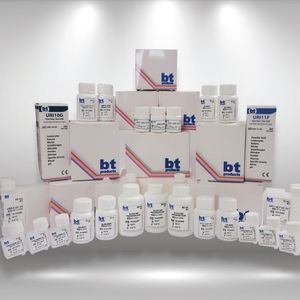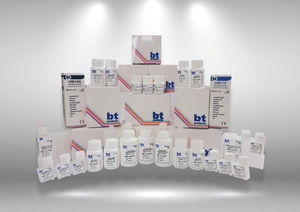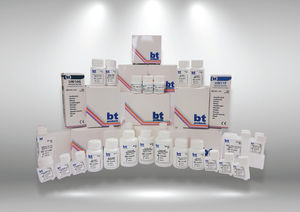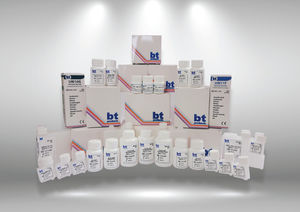
- Laboratory
- Laboratory medicine
- Solution reagent
- BILIMSEL TIBBI ÜRÜNLER
Cholesterol reagent kit CHO-10 seriessolutiondiagnosticclinical
Add to favorites
Compare this product
Characteristics
- Type
- solution
- Applications
- diagnostic, clinical, for biochemistry
- Tested parameter
- hemoglobin, sodium, cholesterol, bilirubin, triglycerides
- Storage temperature
Min.: 2 °C
(36 °F)Max.: 8 °C
(46 °F)
Description
For the in vitro quantitative determination of Total Cholesterol in serum
METHODOLOGY
Alain and Roeschlau began using cholesterol esterase and oxidase,in a single reagent to determine total cholesterol in serum. Trinder’s color system of peroxidase / phenol/4-aminoatipyrine has been used successfully for some time now. The system’ s only drawback was the corrosive properties of phenol. The present method utilizes a phenol substitute that performs like phenol but without being corrosive.
The intensity of the red color produced is directly proportional to the total cholesterol in the sample when read at 500nm.
PRECAUTIONS
1. This reagent is for in vitro diagnostic use only.
2. Reagent contains sodium azide. Poison. Do not ingest .
REAGENT PREPARATION
Reagent is supplied ready to use.
REAGENT DETERIORATION
The reagent should not be used if:
1. The reagent is turbid.
2. The working reagent does not meet stated performance parameters.
INTERFERENCES
Studies to determine the level of interference for hemoglobin, bilirubin, and lipemia were carried out, the following results were obtained:
Hemoglobin: No significant interference ( 10%) from hemoglobin up to 200 mg/dL.
Bilirubin: No significant interference ( 10%) from bilirubin up to 19.8 mg/dL.
Lipemia : No significant interference( 10%)from lipemia up to 1093 mg/dl measured as triglycerides.
ADDITIONAL EQUIPMENT REQUIRED BUT NOT PROVIDED:
1. A clinical chemistry analyzer capable maintaining constant temperature (37°C), and measuring absorbance at 500±20 nm.
2. Iron-free deionized water and related equipment, e.g.: pipettes
Catalogs
No catalogs are available for this product.
See all of BILIMSEL TIBBI ÜRÜNLER‘s catalogsOther BILIMSEL TIBBI ÜRÜNLER products
Universal Bottled Clinical Chemistry Reagents
Related Searches
- Solution reagent kit
- Protein reagent kit
- Diagnostic reagent kit
- Laboratory reagent kit
- Enzyme reagent kit
- Histology reagent kit
- Dye reagent
- Antibody
- Buffer solution reagent kit
- Clinical chemistry reagent
- Quality control reagent kit
- Clinical chemistry analyzer
- Clinical reagent kit
- Virus reagent kit
- Automatic clinical chemistry analyzer
- Benchtop clinical chemistry analyzer
- Test strip
- Tissue reagent kit
- Electrolyte reagent kit
- Colorimetric reagent kit
*Prices are pre-tax. They exclude delivery charges and customs duties and do not include additional charges for installation or activation options. Prices are indicative only and may vary by country, with changes to the cost of raw materials and exchange rates.













































